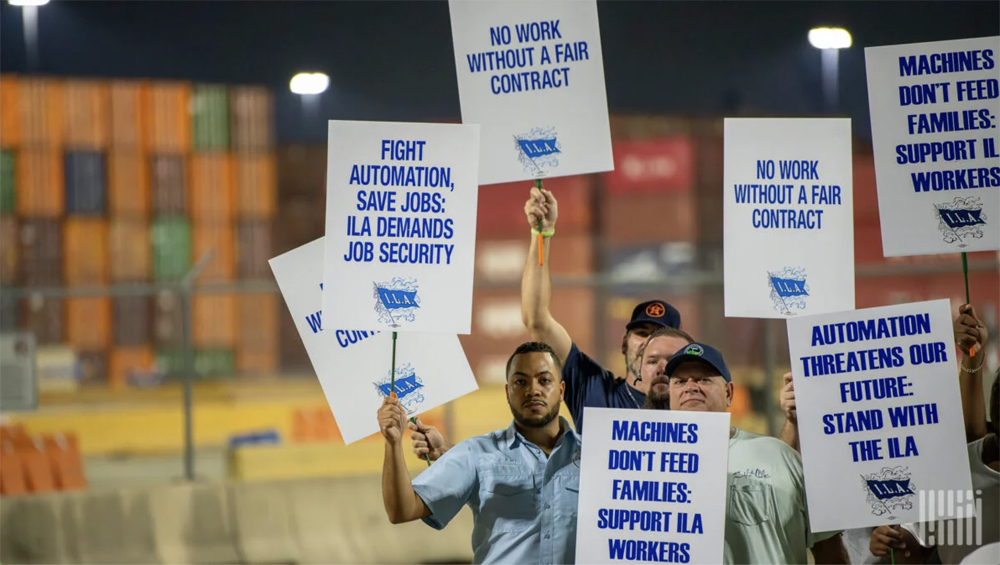
The strike by dockworkers that shut down East Coast ports came to an end today (Thursday, Oct. 3) when the International Longshoremen’s Association and the United States Maritime Alliance announced they had come to a tentative agreement on wages and an extension of the master contract.
The agreement ended the strike on its third day.
The first ILA strike in five decades saw 45,000 union employees walk off the job and bring container and roll-on-roll-off cargo handling to a halt at 36 ports across 14 major marine hubs from New England to Texas.
Rumors of a settlement swirled Thursday, just days after President Joe Biden scolded employers for not bargaining in good faith and urged a resumption to negotiations. The settlement clears a potential major issue for Democrats with the general election just weeks away.
The new deal, which sources close to the talks said came together quickly, provides a pay raise of 61%, or $4 per hour over each of the six years of the pact, and extends the master contract to Jan. 15, 2025, to allow the sides to negotiate outstanding issues. A final agreement would still have to be ratified by union members.
In a joint statement, the sides said all current job actions will cease immediately and all work covered under the master contract will resume although the timeline for that was not specified.
“I want to applaud the International Longshoremen’s Association and the United States Maritime Alliance for coming together to reopen the East Coast and Gulf ports,” Biden said in a statement. “Today’s tentative agreement on a record wage and an extension of the collective bargaining process represents critical progress towards a strong contract. I congratulate the dockworkers from the ILA, who deserve a strong contract after sacrificing so much to keep our ports open during the pandemic. And I applaud the port operators and carriers who are members of the U.S. Maritime Alliance for working hard and putting a strong offer on the table.
“I want to thank the union workers, the carriers, and the port operators for acting patriotically to reopen our ports and ensure the availability of critical supplies for Hurricane Helene recovery and rebuilding. Collective bargaining works, and it is critical to building a stronger economy from the middle out and the bottom up.”
The substantial wage increase by employers came as something of a surprise. The ILA had been firm about seeking a wage hike of $5 per hour while terminal operators and shipping lines were offering around $3. The USMX on Wednesday said they were open to negotiating but wouldn’t do it under ILA pre-conditions.
The tentative agreement was reached as the number of vessels waiting outside ports continued to increase and major retailers were forced to wait for their imports amid fears of shortages of medicines, fresh fruits, and other vital goods. Exporters including manufacturers and agri-businesses were also caught in a squeeze waiting for ports to reopen. Container lines were prepping surcharges to account for extended voyages if a longer strike forced them to divert ships to West Coast ports.
Some traffic had already been diverted to the West Coast, leading to increasing intermodal traffic for BNSF Railway and Union Pacific.
— This article originally appeared at FreightWaves.com. Updated Oct. 4 at 9:25 a.m. CT to correct details of pay raise to $4 per hour over each of the six years of the contract.














Just remember, when the union wins, the consumers and taxpayers lose.
The picketer says “Fight Automation, save jobs” Noble but useless. Just look at the number of men that unload a ship now vs. the 50’s and 60’s. I saw my railroad go from 4 m4n to 3 then 2 with the one eyed flagman replacing the caboose. Ships can now unload themselves and containers and box cars no longer require a ‘checker’ to log their whereabouts.
I’m in the fall of life and retired and not here to ‘blether’ over expert numbers. But time marches on and the tide won’t be stopped on automation.
The ILA realized one undesired outcome of the strike. would likely occur if there were grocery shortages or hyper inflation… President Trump.
That’s the impression I get now that a few days have gone by. It looks like the really hard bargaining will take place after Jan.15th. It looks like the ILA has struck a deal to get past the elections and hope the new administration is a continuation of the old one.
Great news!!
Re: automation issues, the article says “The new deal…. provides a pay raise of 61%, or $4 per hour over the six years of the pact, and extends the master contract to Jan. 15, 2025, to allow the sides to negotiate outstanding issues.” So automation negotiations are still on the table. Here’s a provocative excerpt from a Wall St Journal op-ed article, “…there were 50,000 or so ILA strikers but only 25,000 or so port jobs….only about half of the union’s members are obliged to show up to work each day. The rest sit at home collecting “container royalties” negotiated in previous ILA contracts intended to protect against job losses that result from innovation [ie presumably automation].”
The article has nothing in it about the automation issues which in the long run were the most important for the future of the ports.
Yeah, I was wondering the same. Sounds like we can look forward to another port strike next year at this time.
How about in three months — in mid January?